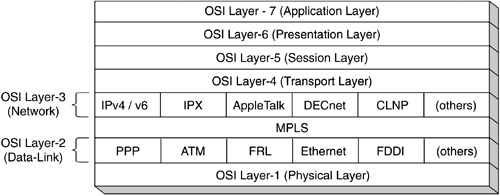Chapter 21. MPLS Introduction
This chapter covers the following topics:
MPLS Terminology
MPLS Operation
MPLS-VPNs
MPLS CE Routing
MPLS stands for Multiprotocol Label Switching and is a packet-forwarding technology. Where Internet Protocol (IP) networks, such as the Internet, use the network IP address to make routing and forwarding decisions, MPLS uses labels. MPLS was designed to give routers greater speed than Asyncronous Transfer Mode (ATM) switches for carrying IP traffic by enabling routers to make forwarding decisions based on labels, avoiding the packet-by-packet look-ups used in conventional routing. With MPLS, the Layer 3 header analysis is done once when the packet enters the MPLS network domain; label inspection determines subsequent packet forwarding. It is this operation that enables MPLS to provide for the following applications across a network backbone: Virtual Private Networking (VPN), Traffic Engineering (TE), Quality of Service (QoS), and ATM over MPLS (AToM).
MPLS is considered a mediator between Layers 2 and 3 (the Data-Link and Network layers, respectively) of the Open System Interconnection (OSI) Reference Model, as illustrated in Figure 21-1. MPLS is sometimes referred to as working at Layer 2.5 of the OSI Reference Model. As its name implies, MPLS can support multiple protocols, although the common implementation is IP over Point-to-Point Protocol (PPP)/ATM.
Figure 21-1. MPLS Model (Multiprotocol)

In addition to being a forwarding mechanism, MPLS provides for the (traffic) engineering of IP flows in a similar fashion to ATM Permanent Virtual Circuits (PVCs); in other words, MPLS moves the traffic engineering from layer 2 (ATM) to layer 3 (IP). MPLS Traffic Engineering (MPLS-TE) is best described as being at Layer 2 to 2.5 of the OSI Reference Model, interworking IP with optical networks, such as Synchronous Optical Network (SONET) and Dense Wave Division Multiplexing (DWDM).
EAN: 2147483647
Pages: 269